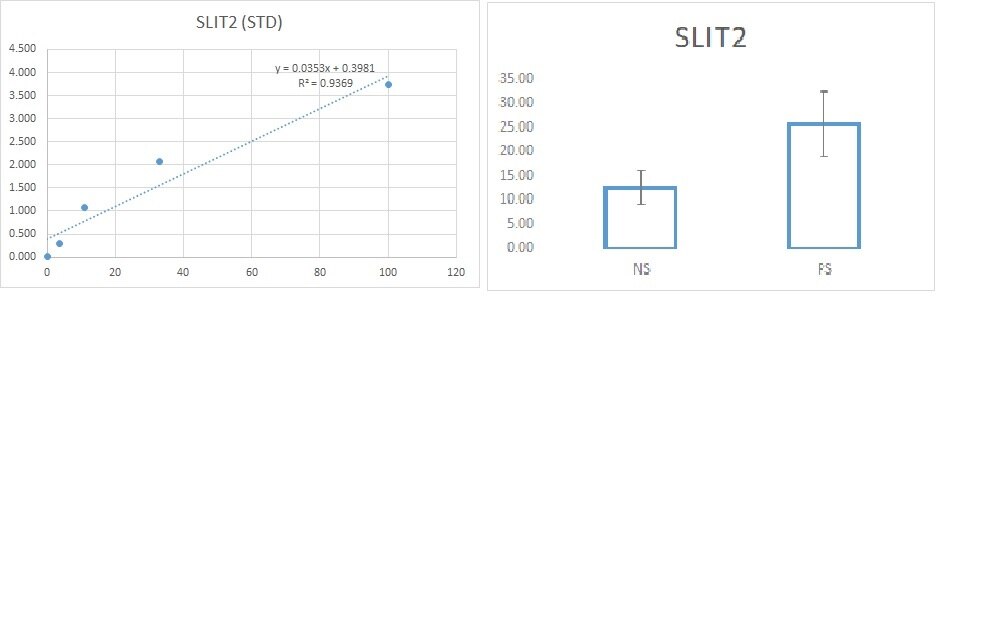Mouse Slit2 Antibody Summary
Gln26-Gln900
Accession # Q9R1B9
Applications
Please Note: Optimal dilutions should be determined by each laboratory for each application. General Protocols are available in the Technical Information section on our website.
Scientific Data
 View Larger
View Larger
Slit2 in Embryonic Mouse Hindlimb. Slit2 was detected in immersion fixed frozen sections of E13.5 mouse hindlimb, shown localized to interdigital region (upper panel), using Sheep Anti-Mouse Slit2 Antigen Affinity-purified Polyclonal Antibody (Catalog # AF5444) at 10 µg/mL overnight at 4 °C. Tissue was stained using the NorthernLights™ 557-conjugated Anti-Sheep IgG Secondary Antibody (red; Catalog # NL010) and counterstained with DAPI (blue). Specific staining was localized to cell surfaces and cytoplasm. View our protocol for Fluorescent IHC Staining of Frozen Tissue Sections.
Preparation and Storage
- 12 months from date of receipt, -20 to -70 °C as supplied.
- 1 month, 2 to 8 °C under sterile conditions after reconstitution.
- 6 months, -20 to -70 °C under sterile conditions after reconstitution.
Background: Slit2
Slit2 is a 180-210 kDa secreted member of the SLIT family of proteins. It is expressed in select sites in the embryo (via glia, motoneurons and posterior sclerotome mesoderm), and found in discrete adult cell types such as preosteoblasts, monocytes, granulose lutein cells, and likely keratinocytes. Slit2 binds to multiple receptors, including ROBO-1 thru -4, laminin-1, Dan, Gremlin and netrin-1. Depending upon the target, Slit2 can promote a number of diverse effects, including both growth cone collapse and outgrowth, inhibition of dendritic cell migration, and axon repulsion. Mature mouse Slit2 is 1496 amino acids (aa) in length (aa 26-1521). It contains multiple intermingled domains, including nine EGF-like domains, 20 Leu-rich repeats (LRRs), one laminin G-like and CTCK (C-terminal Cys knot-like) domain, and eight total C- plus N-terminal LRRs. There are two potential isoform splice variants. One contains a four aa insertion after Ser258, while another possesses the same insertion after Ser258 coupled to both an eight aa insertion after Ser479 and a nine aa insertion after Thr1021. Slit2 apparently undergoes proteolytic cleavage after Arg1113. This generates a 140-150 kDa N-terminal protein, and a 55-60 kDa C-terminal fragment. This processing does not inactivate Slit2. Rather, it creates molecules with distinct activities. For example, the N-terminal fragment will bind ROBO-1 and repel motor axon migration, while the C-terminal fragment won't bind ROBO-1, but will bind glypican-1 and promote motor axon migration. Over aa 26-900, mouse SLIT2 shares 99% and 97%aa sequence identity with rat and human Slit2, respectively.
Product Datasheets
Citation for Mouse Slit2 Antibody
R&D Systems personnel manually curate a database that contains references using R&D Systems products. The data collected includes not only links to publications in PubMed, but also provides information about sample types, species, and experimental conditions.
1 Citation: Showing 1 - 1
-
A Multiplexed Barcodelet Single-Cell RNA-Seq Approach Elucidates Combinatorial Signaling Pathways that Drive ESC Differentiation
Authors: GHT Yeo, L Lin, CY Qi, M Cha, DK Gifford, RI Sherwood
Cell Stem Cell, 2020-05-26;26(6):938-950.e6.
Species: Mouse
Sample Types: Whole Cells
Applications: ICC
FAQs
No product specific FAQs exist for this product, however you may
View all Antibody FAQsReviews for Mouse Slit2 Antibody
Average Rating: 5 (Based on 1 Review)
Have you used Mouse Slit2 Antibody?
Submit a review and receive an Amazon gift card.
$25/€18/£15/$25CAN/¥75 Yuan/¥2500 Yen for a review with an image
$10/€7/£6/$10 CAD/¥70 Yuan/¥1110 Yen for a review without an image
Filter by:

